By: Meghan Moran, Mike Cowbrough (OMAFRA) and Dr. Darren Robinson (University of Guelph-Ridgetown Campus)
Group 27 herbicides, commonly referred to as “bleaching” herbicides inhibit an enzyme called HPPD (p-hydroxyphenyl pyruvate dioxygenase). Several herbicides containing Group 27 active ingredients are used pre-emergence or early post-emergence in corn. Dry beans are often grown after corn in rotation and bleaching symptoms have been observed in dry beans planted too soon following application of the Group 27 product, or where conditions have slowed herbicide breakdown.
Certain market classes of dry beans can be extremely sensitive to “bleaching” herbicide carryover or drift. The following four figures summarize Ontario research on the affect of bleaching herbicide carryover on dry bean injury and yield in the year following herbicide application.
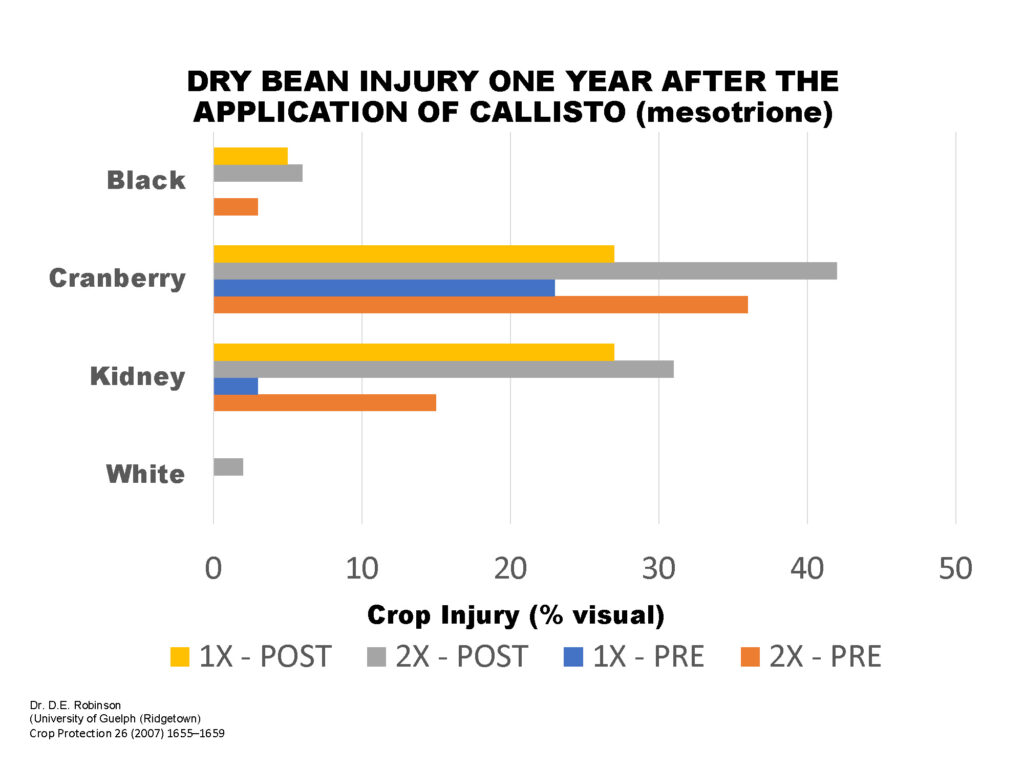
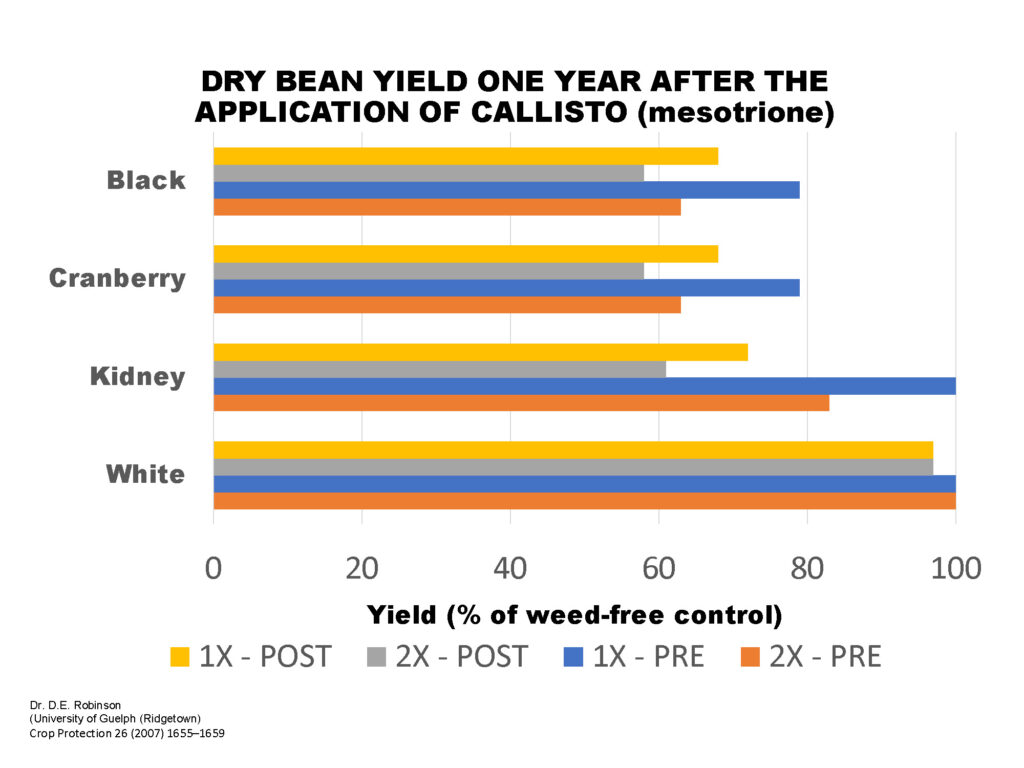
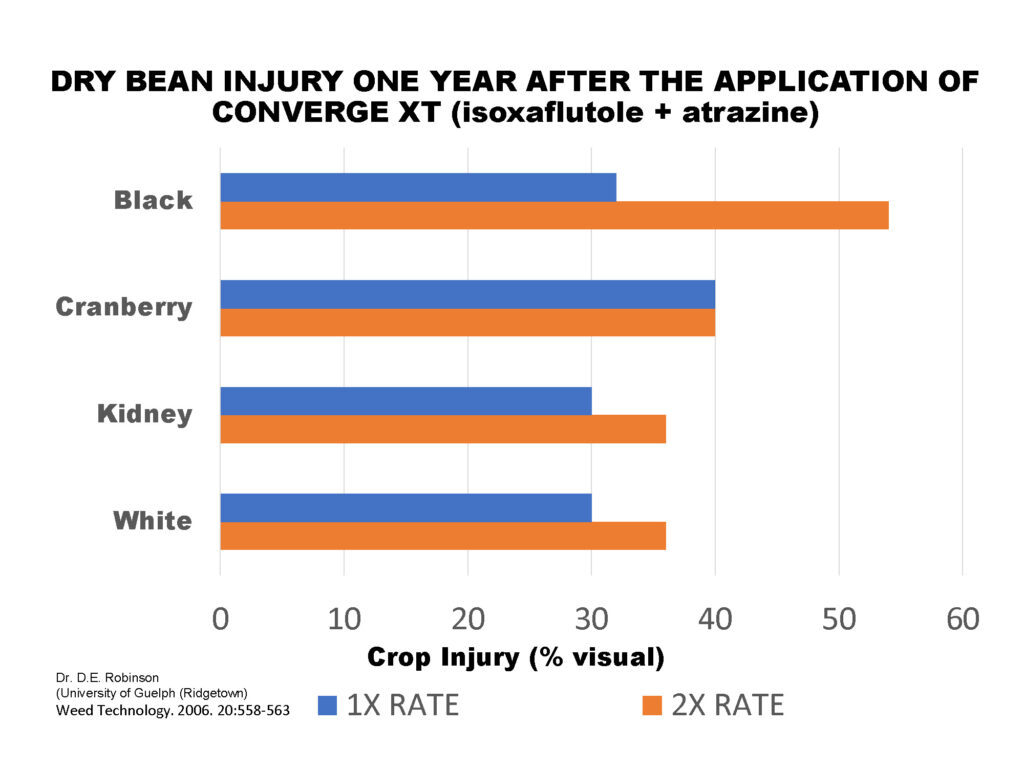

What the herbicide label tells you
The herbicide label states how much time is needed after the herbicide has been applied before a crop can safely be planted. These guidelines are often listed under the heading of “rotational crops” or “re-cropping guidelines”. They are typically expressed in months and usually err on being cautious. They are based on trial data where twice the labelled herbicide rate was applied the previous year. Some of the Group 27 products commonly used in corn are listed in the table below along with the re-cropping restriction to white beans.
Table 1. Re-crop interval, in months after the application of “Group 27” herbicides, where white beans can be safely planted.
| Herbicide Trade Name(s) | Group 27 Active Ingredient | Re-crop Interval for white Beans (months) |
| Acuron | mesotrione and bicyclopyrone | Label does not provide re-crop interval, field bioassay required |
| Armezon | topramezone | 10 |
| Callisto | mesotrione | 11 |
| Converge XT | isoxaflutole | 22 |
| Engarde | mesotrione | 11 |
| Halex GT | mesotrione | 11 |
Symptoms
Group 27 injury on dry beans will appear as new growth bleached white or yellow. Symptoms may not show up until the second trifoliate in dry beans. Injured tissue typically turns necrotic over time.
Symptoms of herbicide carryover are usually not spread evenly across a field. There may be more injury where:
- higher rates were applied, e.g. overlaps or headlands
- herbicide break down is slower
- where dry beans plant are subject to additional plant stresses e.g. compaction or root rot
Injury can be patchy and more variable than expected considering herbicide application is relatively uniform. Within a small area injury levels can range from low to high, and there may appear to be a row-by-row effect. The variability is typically driven by soil factors. These may be obvious changes in soil texture, or less obvious changes in compaction, pH or water holding capacity.
Injury may not occur with a certain practice one year or on one field, but injury may appear with the same practice in another field, another season or a different dry bean market class. Herbicide injury might be greater than expected because of additional plant stresses. Plants may not be able to metabolize herbicide effectively if they have root rot or if temperatures are cool. As another example, having Group 27 herbicide residue present in addition to a 4-way herbicide tank mix for weed control in the current crop may increase risk of injury. If all these stresses are at play, injury could be severe.
How “bleaching” herbicides residues are broken down
Soil microbes break down most herbicide residues. Soil temperature and moisture will affect how quickly this is done. When soil was cool and dry, a Chinese study found that it took over 75 days longer for Callisto herbicide to breakdown1. Microbial activity is higher in soils with high organic matter. Unfortunately, high organic matter soils also bind more herbicide molecules, making them less available for microbial decomposition and slowing their rate of break down.
Soil pH affects how easily herbicide molecules are adsorbed by soil particles. When herbicide molecules “stick” more easily to soil particles, it takes longer for those molecules to “break off” into the soil water where they can be decomposed by microbes or taken up by plants. For example, at lower soil pH’s (6.5 and lower), the bleaching herbicides are more strongly adsorbed by soil particles. An Ontario study found significant differences in Callisto herbicide carryover that was explained by differences in soil pH and soil moisture. Less green bean injury and yield loss was observed when Callisto was applied to soil having a pH of 6.7 and with adequate rainfall throughout the season. Significantly higher green bean injury and yield loss was observed when the same herbicide was applied to soil with a pH of 6 and where rainfall was about 22% lower (Table 2).
Table 2. Effect of Callisto soil residues on injury and yield of green (snap) bean at 1 year after application to corn under two different soil conditions2.
| Soil conditions | No herbicide (control) | Callisto 1X rate | Callisto 2X rate |
| pH = 6
460 mm rainfall |
0% crop injury | 44% crop injury | 64% crop injury |
| 4.24 MT/acre | 2.68 MT/acre | 1.52 MT/acre | |
| pH = 6.7
593 mm rainfall |
0% crop injury | 18% crop injury | 40% crop injury |
| 3.73 MT/acre | 3.73 MT/acre | 3.73 MT/acre |
Depending on the extent of the injury, dry beans may recover from Group 27 carryover injury. Unless the growing point looks necrotic, plants should continue to grow and look healthier within 7-10 days. Injured plants may be stunted or have delayed maturity, or both. Delayed or variable maturity may translate to challenges with timing of pre-harvest herbicide applications and combining. Re-plant decisions should be made based on what percent of plants are significantly injured. There should be at least 65 to 75% of a full stand of surviving plants. The date should also be considered; ensure the replanted crop will mature in time for harvesting in September. It is not advisable to re-seed patches in an existing field, as this will also cause maturity issues at harvest. Terminate the injured field with glyphosate prior to re-seeding.
What can be done to avoid this type of injury in the future
- Ensure that labelled rotational restrictions are known and can be followed.
- Adjust soil pH so that it is above 6.5 and below 7.5.
- Monitor seasonal rainfall and crop heat units. If they are below normal, consider planting crops that have no restrictions on when they can be planted following Group 27 herbicide application.
- Till crop residues in the fall before planting. Heavy crop residues will lower soil temperatures and slow microbial degradation. Tillage will reduce (but not eliminate) the risk of injury by incorporating herbicide residues deeper into the soil profile, thereby diluting potency.
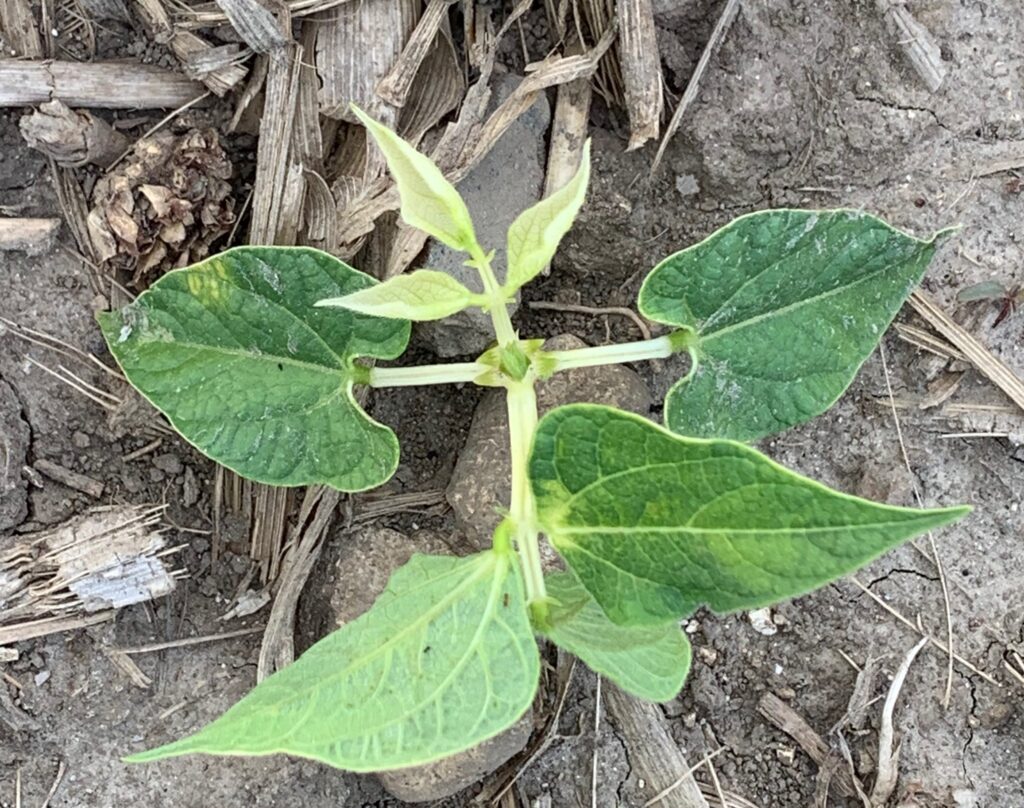

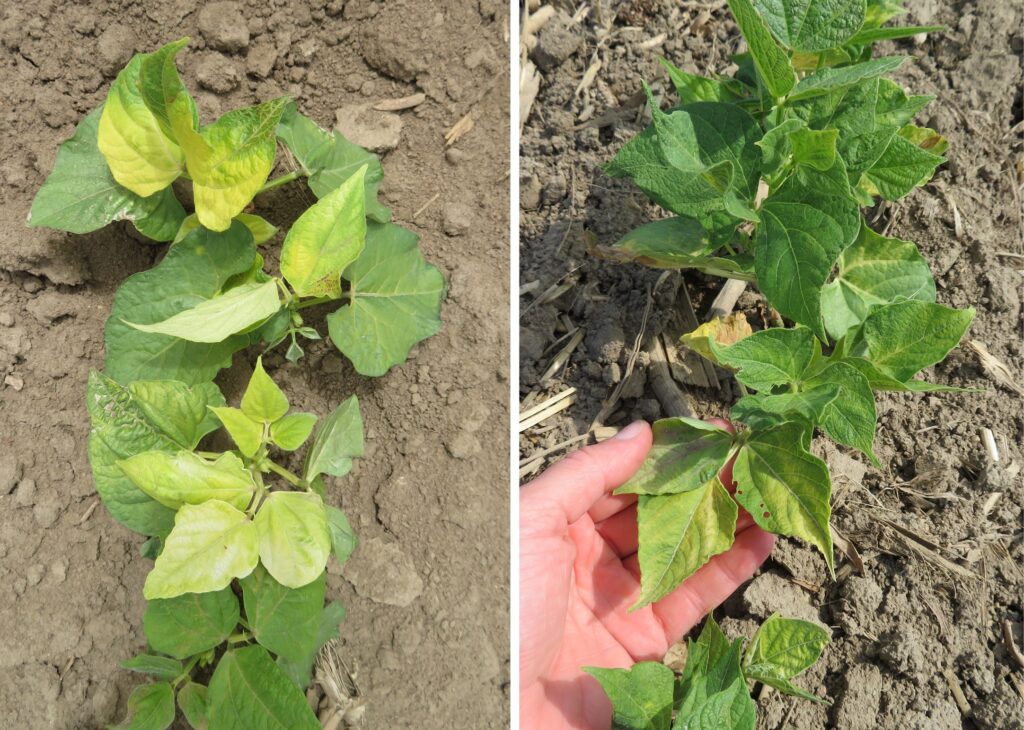



References
1. Bull Environ Contam Toxicol (2017) 98:212–217.
2. Weed Technology (2013) 27:92—100.
